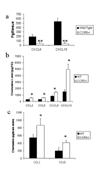Abnormal immune response of CCR5-deficient mice to ocular infection with herpes simplex virus type 1
- PMID: 16476970
- PMCID: PMC1479868
- DOI: 10.1099/vir.0.81339-0
Abnormal immune response of CCR5-deficient mice to ocular infection with herpes simplex virus type 1
Abstract
Ocular herpes simplex virus type 1 (HSV-1) infection elicits a strong inflammatory response that is associated with production of the beta chemokines CCL3 and CCL5, which share a common receptor, CCR5. To gain insight into the role of these molecules in ocular immune responses, the corneas of wild-type (WT) and CCR5-deficient (CCR5-/-) mice were infected with HSV-1 and inflammatory parameters were measured. In the absence of CCR5, the early infiltration of neutrophils into the cornea was diminished. Associated with this aberrant leukocyte recruitment, neutrophils in CCR5-/- mice were restricted to the stroma, whereas in WT mice, these cells trafficked to the stroma and epithelial layers of the infected cornea. Virus titres and cytokine/chemokine levels in the infected tissue of these mice were similar for the first 5 days after infection. However, by day 7 post-infection, the CCR5-/- mice showed a significant elevation in the chemokines CCL2, CCL5, CXCL9 and CXCL10 in the trigeminal ganglion and brainstem, as well as a significant increase in virus burden. The increase in chemokine expression was associated with an increase in the infiltration of CD4 and/or CD8 T cells into the trigeminal ganglion and brainstem of CCR5-/- mice. Surprisingly, even though infected CCR5-/- mice were less efficient at controlling the progression of virus replication, there was no difference in mortality. These results suggest that, although CCR5 plays a role in regulating leukocyte trafficking and control of virus burden, compensatory mechanisms are involved in preventing mortality following HSV-1 infection.
Figures








Similar articles
-
Pathogenesis of herpetic stromal keratitis in CCR5- and/or CXCR3-deficient mice.Curr Eye Res. 2008 Sep;33(9):736-49. doi: 10.1080/02713680802344716. Curr Eye Res. 2008. PMID: 18798077
-
CXCL10/CXCR3-Dependent Mobilization of Herpes Simplex Virus-Specific CD8+ TEM and CD8+ TRM Cells within Infected Tissues Allows Efficient Protection against Recurrent Herpesvirus Infection and Disease.J Virol. 2017 Jun 26;91(14):e00278-17. doi: 10.1128/JVI.00278-17. Print 2017 Jul 15. J Virol. 2017. PMID: 28468883 Free PMC article.
-
Herpes simplex virus type 1 induction of chemokine production is unrelated to viral load in the cornea but not in the nervous system.Viral Immunol. 2006 Winter;19(4):741-6. doi: 10.1089/vim.2006.19.741. Viral Immunol. 2006. PMID: 17201669 Free PMC article.
-
CD4+ T cell migration into the cornea is reduced in CXCL9 deficient but not CXCL10 deficient mice following herpes simplex virus type 1 infection.Cell Immunol. 2006 Oct;243(2):83-9. doi: 10.1016/j.cellimm.2007.01.001. Epub 2007 Feb 12. Cell Immunol. 2006. PMID: 17296171 Free PMC article.
-
[Battle with herpes for 37 years].Nippon Ganka Gakkai Zasshi. 2015 Mar;119(3):145-66; discussion 167. Nippon Ganka Gakkai Zasshi. 2015. PMID: 25854108 Review. Japanese.
Cited by
-
Intact TRL 9 and type I interferon signaling pathways are required to augment HSV-1 induced corneal CXCL9 and CXCL10.J Neuroimmunol. 2006 Oct;179(1-2):46-52. doi: 10.1016/j.jneuroim.2006.06.020. Epub 2006 Aug 1. J Neuroimmunol. 2006. PMID: 16884784 Free PMC article.
-
Circulating herpes simplex type 1 (HSV-1)-specific CD8+ T cells do not access HSV-1 latently infected trigeminal ganglia.Herpesviridae. 2011 Mar 15;2(1):5. doi: 10.1186/2042-4280-2-5. Herpesviridae. 2011. PMID: 21429183 Free PMC article.
-
Absence of CCR5 increases neutrophil recruitment in severe herpetic encephalitis.BMC Neurosci. 2013 Feb 7;14:19. doi: 10.1186/1471-2202-14-19. BMC Neurosci. 2013. PMID: 23391218 Free PMC article.
-
Neuroinvasion and Inflammation in Viral Central Nervous System Infections.Mediators Inflamm. 2016;2016:8562805. doi: 10.1155/2016/8562805. Epub 2016 May 25. Mediators Inflamm. 2016. PMID: 27313404 Free PMC article. Review.
-
The immune response to herpes simplex virus encephalitis in mice is modulated by dietary vitamin E.J Nutr. 2008 Jan;138(1):130-7. doi: 10.1093/jn/138.1.130. J Nutr. 2008. PMID: 18156415 Free PMC article.
References
-
- Algood HMS, Flynn JL. CCR5-deficient mice control Mycobacterium tuberculosis infection despite increased pulmonary lymphocytic infiltration. J. Immunol. 2004;173:3287–3296. - PubMed
-
- Appay V, Rowland-Jones SL. RANTES: a versatile and controversial chemokine. Trends Immunol. 2001;22:83–87. - PubMed
-
- Banerjee K, Biswas PS, Kim B, Lee S, Rouse BT. CXCR2-/- mice show enhanced susceptibility to herpetic stromal keratitis: A role for IL-6-induced neovascularization. J. Immunol. 2004;172:1237–1245. - PubMed
-
- Belnoue E, Kayibanda M, Deschemin JC, Viguier M, Mack M, Kuziel WA, Renia L. CCR5 deficiency decreases susceptibility to experimental cerebral malaria. Blood. 2003;101:4253–4259. - PubMed
-
- Biswas PS, Banerjee K, Kim B, Rouse BT. Mice transgenic for IL-1 receptor antagonist protein are resistant to herpetic stromal keratitis: Possible role for IL-1 in herpetic stromal keratitis pathogenesis. J. Immunol. 2004;172:3736–3744. - PubMed
Publication types
MeSH terms
Substances
Grants and funding
LinkOut - more resources
Full Text Sources
Molecular Biology Databases
Research Materials

